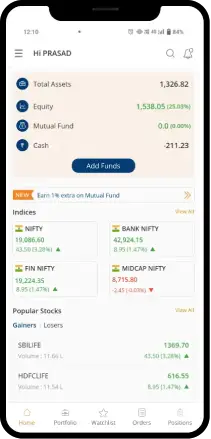Features of Open Ended Mutual Funds
-
Investors buy units directly from the fund house rather than from existing unitholders.
-
There are no restrictions on the number of units that can be issued.
-
Highly liquid, open-ended funds help investors benefit from dynamic market movements.
-
Units of open-ended mutual funds can be bought and sold even after the new fund offer period.
Benefits of Open Ended
Mutual Funds

-
Benefit of high liquidity
Open-ended funds have no lock-in period, facilitating investors to invest or redeem at prevailing NAV and take advantage of market ups and downs. -
Perfect for SIP investors
Open-ended funds allow SIPs, helping investors enjoy Rupee Cost Averaging. It also reduces the hassle of timing the market via lumpsum investing. -
Better decision making
With access to historical performance, investors can analyse and monitor a fund’s track record and make informed choices before investing. -
Superior diversification
In open-ended mutual funds, fund managers can diversify across themes and sectors as per market outlook. This helps generate better risk-adjusted returns.
Types of Open Ended Mutual Funds
-
1
Equity mutual funds
Invest in stocks listed on the exchange and benefit from capital appreciation and dividend income. Equity funds can be large cap, mid cap, or small cap oriented.
-
2
Debt mutual funds
Benefit from fixed interest instruments like corporate bonds, government securities, non-convertible debentures etc. Debt funds can be short term, dynamic, and long term.
-
3
Hybrid mutual funds
A mix of equity and debt, hybrid funds provide both capital appreciation via equity and stable interest income through debt. They range from aggressive to conservative.
-
4
Money market funds
A subset of debt funds, money market funds invest in highly liquid and safe instruments like commercial papers, treasury bills, certificate of Deposits etc.
Mutual Funds Calculator
Evaluate future value of your SIP and Lumpsum investments.
-
Investment Type
-
Monthly Investment
₹ -
Expected Returns Rate
% -
Time Period
yrs
Future value of your investment
₹ 0
Returns
-
Invested Amount
0
-
Estimated Returns
0
-
Select Scheme
-
Investment Type
-
Monthly Investment
₹ -
Time Period
Total of your Investment will be
₹ 0
Returns
-
Invested Amount
0
-
Estimated Returns
0
Taxation of Open Ended Mutual Funds
| Type of open-ended fund | Holding period | Capital gains | Tax rate |
|---|---|---|---|
| Equity-oriented | Less than 12 months | Short term capital gains (STCG) | 15% |
| More than 12 months | Long term capital gains (LTCG) | 10% - on gains exceeding ₹1 lakh in a financial year Nil – If gains are less than ₹1 lakh in a financial year | |
| Debt-oriented | Less than 36 months | Short term capital gains (STCG) | As per income tax slab |
| More than 36 months | Long term capital gains (LTCG) | 20% post indexation |
Here's what the world has to say
We bring simplicity and ease to investing, along with exceptional customer expereince that our user admire

“Mujhe m.Stock trading app use karne mei bohot accha lagta hai. Mei ye app sabko recommend karta hu aur future mei bhi karunga!”

“m.Stock share market trading app is ideal for investments. Easy to read dashboard & I can access it easily to check my portfolio.”

“The messages and initiation that I got at every step, is the best without any jargons. There were samples and screens that helped a lot.”

“A very intuitive platform. Barely took a few minutes to apply online and complete the KYC. 1-click order placement. Kudos m.Stock team!”

“m.Stock trading app itna simple ki koi bhi yeh app use kar sakte hai. Unke live market updates right moves lene me help karta he.”

“m.Stock trading app main apne dost ko bhi recommend kiya hu and even they are now happy traders! Zero brokerage is the best! Thank you m.Stock! ”
FAQs on Open Ended Mutual Funds
Yes, since open ended funds are available for subscription throughout the year, you can start a systematic investment plan in an open ended fund. This will provide multiple benefits – firstly, since you are investing via a systematic plan, you can start with as little as ₹100. Secondly, you can leverage the power of Rupee Cost Averaging which isn’t possible when you invest a lumpsum amount.
Open-ended schemes are highly popular among retail investors since they allow SIPs. Investors seeking high liquidity should opt for open-ended funds since they are open for purchase and redemption throughout the year. To further bi-furcate open ended funds, large cap funds are ideal for conservative investors whereas mid and small cap funds would be apt for aggressive investors with a long term investment horizon.
There is no lock-in period for open-ended schemes. Investors can enter and exit anytime. This helps them in various ways, such as Rupee Cost Averaging, starting small with just ₹100, avoid timing the market, all of which is not possible with close ended funds.
When you exit from an open-ended mutual fund, the value of your units is calculated based on the net asset value (NAV) of the scheme, on the day of redemption. Net asset value is calculated as total assets minus total liabilities divided by total number of units issued.
In open-ended mutual funds, there are exit loads (charges) if an investor exits the fund within a preset period, typically, one year in the case of equity funds. For short-term debt funds, the exit load period is typically less than 6 months whereas for liquid funds, the exit load period is 15 days to 30 days.
Power your investments with our smart trading platforms





